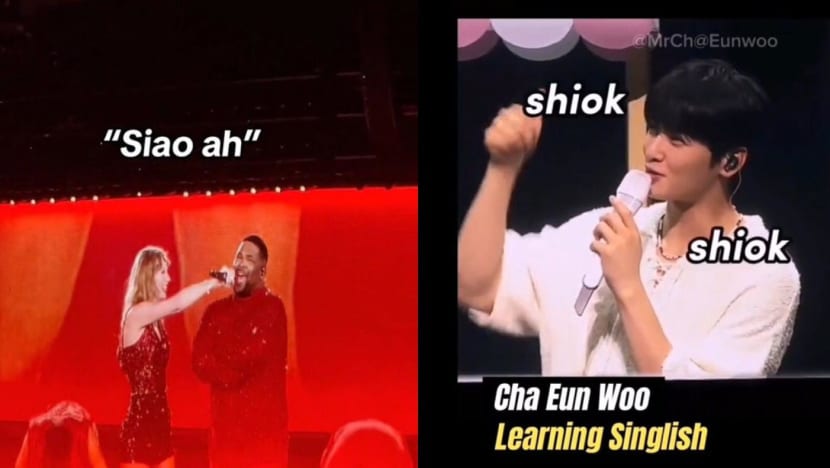Commentary: Is Singlish going global?

From Taylor Swift dancer Kameron Saunders to K-pop idol Cha Eun-woo, foreign gigs performing in Singapore in recent months are learning and using Singlish. (Images: TikTok/@.thejos and @mr.ch.eun.woo)
SINGAPORE: Every other foreign gig who’s performed in Singapore in recent months seems to be learning and using Singlish.
At Taylor Swift’s Eras Tour at the National Stadium in March, Swift's dancer, Kameron Saunders, delighted fans by using a different Singlish expression on each night of the concert. From “alamak” to “siao ah”, Saunders’ precise delivery sent the crowd wild; observers at home too were mostly impressed by how apt the Singlish usage was.
K-pop idol Cha Eun-woo came to town for his one-day concert on Apr 13, and his attempts on using "aiyoh”, "shiok" and "wah lau eh" were met with rapturous cheers from the crowd.
South Korean star IU came a week later and dropped a few Singlish words on her adoring fans. And on May 1, Hong Kong boy group Mirror did the same in their concert.
This antic seems to be getting stale, except it is not - and is likely going to be a staple of future acts in town.
In fact, the use of Singlish by foreigners is not restricted to pop culture. New York City recently saw a new cocktail bar, owned and run by two non-Singaporeans, named no other than Singlish. The bar serves cocktails with names such as Ho Seh Boh, Chope, and Die Die Must Have.
Why is Singlish being used by non-Singaporeans? Are these indications that Singlish is gaining fame and recognition internationally?
STEADY POM PI PI
Whether we like Singlish or not, it is apparent that Singlish has now become a unique symbol of Singaporean culture and identity.
Singlish is special because it is unlike other languages in the world. I have written previously that Singlish is not English, and Singlish has evolved independently of English. It is a contact language that is borne out of a local language ecology that comprises many different languages, the earliest contributors being Bazaar Malay and Hokkien.
Contact language arises when speakers of different language communities interact with one another in a multilingual context for a sustained period of time, which results in a mixture of linguistic features across different languages.
Many of these linguistic features change and can take on different meanings from the source languages they come from.
Singlish is truly a language born and bred in Singapore. In some way, this process is very much like how children create “play” languages to mark their inner circles of friendships. Likewise, Singlish has also become a “play” language that Singaporeans have created and then share as a familiar code for communication.
It is precisely the uniqueness and playfulness of Singlish that has made it possible for Singlish to be commodified.
DON’T PLAY PLAY
What is language commodification? Language commodification refers to the process of having a language turned into a product that can be marketed and sold.
There are many instances of Singlish being commodified. The most obvious is in the form of merchandise bearing Singlish words or phrases. One can see numerous shops selling T-shirts, bags, badges and mugs with Singlish words printed on them, making them quaint tourist souvenirs.
The New York City cocktail bar is another classic example of how Singlish is commodified. Not only is the bar named Singlish, it also sells Singlish-named cocktails.
Commodification can also be seen in advertisements. International companies, from McDonald's to Subaru, use Singlish in their advertising campaigns as part of their marketing plan to appeal to local customers.
Even the government makes use of Singlish as a branding exercise when they want Singaporeans to buy into a sense of national pride, and we can see this in Singlish floats paraded in the SG50 National Day celebrations in 2015 as well as Singlish posters and social media posts publicising the Singapore Day events for Singaporeans abroad.
During the SARS and COVID-19 pandemics, the government roped in Singapore’s much-loved contractor Phua Chu Kang - the main character of the popular 1990s TV sitcom - for a series of rap music videos to disseminate important health information.
These videos were peppered liberally with Singlish phrases. The COVID-19 videos such as Get Your Shot, Steady Pom Pi Pi, and PCK - Singapore Be Steady!, went viral and caught the attention of international media. Both videos have garnered 1.7 million views each on YouTube to date.
Therefore, when foreign artistes come to Singapore and start using Singlish, it is not because they really want to learn the language. And it is definitely not because Singlish has gained international acclaim. Rather, it is all part of a very clever marketing strategy.
Choice Singlish words and phrases are packaged and used by foreign artistes as a product that can provide humour and entertainment. At the same time, when these foreign artistes use Singlish, they are letting themselves in on this code, a code that is used exclusively by Singaporeans. In doing so, these artistes are using Singlish as a way to connect with the local audience.
With Singlish getting all this attention today, it is hard not to be reminded of how Singlish was once seen as “ungrammatical” and “broken”. In 1974, Dick Lee’s song Fried Rice Paradise was banned from national radio for improper use of English.
Singlish may not be a global language in the way English is, but Singlish definitely sells.

No comments
Share your thoughts! Tell us your name and class for a gift (: